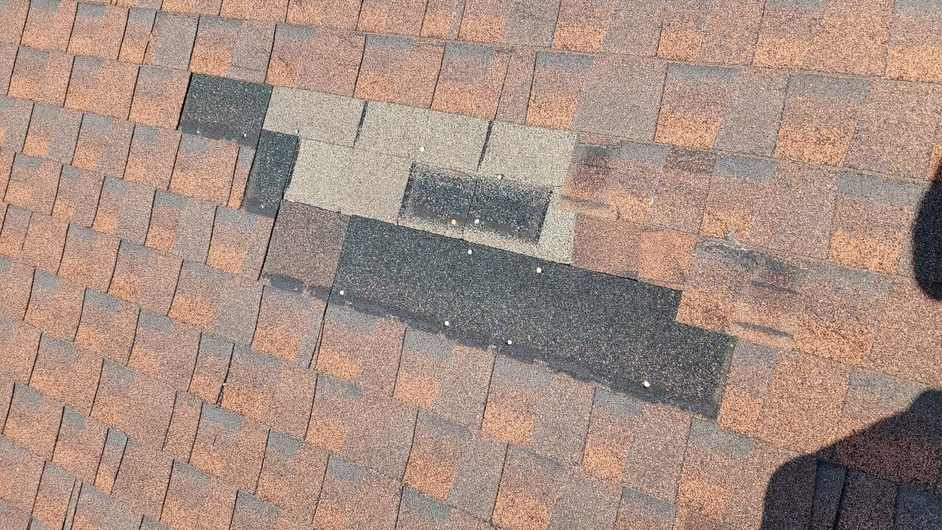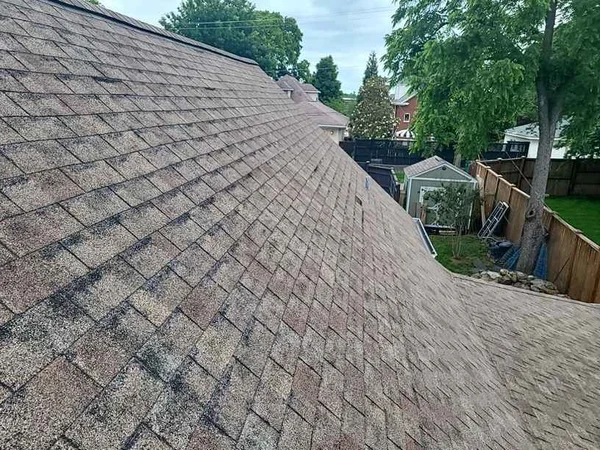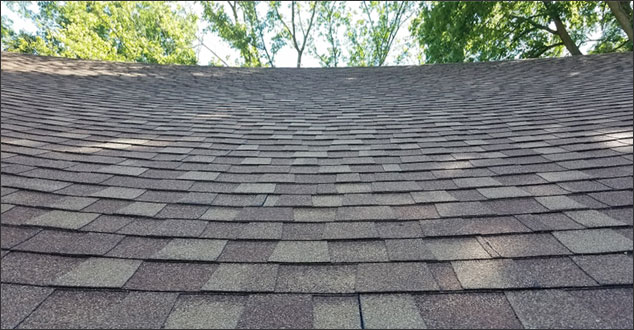Here's the bottom line: If your roof is under 15 years old and the damage covers less than 30% of the surface, repair it. If it's over 20 years old or has widespread damage, replace it. Everything in between? That's where things get interesting.
Your roof doesn't come with a dashboard warning light. It just starts failing and usually at the worst possible time. We're going to walk you through exactly how to make this decision without the guesswork.
The Quick Decision Framework
Let's cut through the confusion with a simple rule of thumb.
Repair makes sense when:
- Damage is isolated to one area
- Your roof is less than halfway through its expected lifespan
- The repair costs less than 25% of a full replacement
- You're buying yourself at least 5 more years
Replacement makes sense when:
- Multiple areas are failing (not just one leak spot)
- You're past the 15-year mark on asphalt shingles
- Repair costs keep adding up year after year
- You're seeing structural issues like sagging or rot
Of course, these are only guidelines. Your specific situation matters more than any chart.
How Age Changes Everything
Here's the thing: a 5-year-old roof with storm damage is completely different from a 22-year-old roof with the same damage.
Asphalt shingle roofs typically last 20-25 years. Metal roofs can push 50 years. Slate? Try 100 years if properly maintained. But here's what matters: where your roof sits in its lifecycle determines whether throwing money at repairs makes any sense.
Early life (0-10 years): Repairs are usually your best bet because the rest of the roof still has plenty of life left. Fix only what's broken and move on.
Middle age (10-20 years): This is the gray zone. You need to calculate whether repairing now means you'll face replacement costs in just a few years anyway. Honestly sometimes it's smarter to bite the bullet early.
Late life (20+ years): Unless it's a premium material like slate or metal, you're probably looking at replacement because repairs at this stage are like putting a bandage on a bigger problem.
The one thing nobody mentions: matching old shingles is nearly impossible. Even if you saved extras from the original installation, they've weathered differently. Your "repair" might stick out like a sore thumb on the side facing the street.
Reading the Damage: What You're Really Looking At
Alright, let's talk about what different types of damage actually mean for your decision.
Missing shingles: This is usually straightforward repair territory, especially after a storm. But if you're losing shingles regularly then that's telling you the entire roof is reaching the end.

Granule loss: Those little colored bits washing into your gutters? That's the protective layer wearing off. A little loss is normal. Bald spots across multiple areas mean your roof's protection is gone, and you're on borrowed time.

Leak patterns: A single leak from obvious damage (like where a branch hit) is repairable. Multiple leaks or leaks you can't trace to obvious damage mean water's finding paths through aging materials. That's usually a replacement situation.

Structural sag: This isn't even a question. Sagging means the decking below has failed from moisture or the framing is compromised. You need a full tearoff to assess and fix the real problem.

The Cost Reality Check (No Surprises Here)
Roofs don't comes free, so let's talk numbers.
Basic repairs typically run $300-$1,500 for minor work. Replacing a few shingles, sealing a small leak, fixing flashing around a chimney. Quick, contained fixes.
Moderate repairs can hit $1,500-$5,000. This is partial valley replacement, fixing multiple leak points, or addressing a section damaged by a fallen tree. You're getting into territory where a roofing company needs a day or two on site.
Full replacement generally costs $5,500-$12,000 for an average home (1,500-2,000 sq ft), though that varies wildly based on material choice and roof complexity. Metal or tile? Add another $5,000-$15,000 to those numbers.
Here's the math that matters: if repairs are running over $2,000 and your roof is past its midpoint, you're often just delaying the inevitable. That repair money becomes wasted money when you replace the roof in two years anyway.
Timeline Realities: What Actually Happens
Repairs can often happen within a few days of calling. Small jobs might even be same-day if the weather cooperates and materials are on hand.
Full replacement is a different beast. Count on:
- 1-2 weeks for permits (varies by location)
- 1-2 days for tearoff and installation on most homes
- Another week if we discover deck damage that needs addressing
- Potential delays if materials aren't in stock
Right now (and this seems to be permanent), supply chains aren't what they used to be. Specific shingle colors might be backordered, custom metal panels could take weeks so make sure you plan accordingly.
The Building Code Curveball Nobody Warns You About
This catches people off guard constantly but current code might not let you do what seems like the obvious choice.
Most jurisdictions only allow two layers of shingles maximum. If you already have two layers then any work means full tearoff. No exceptions. What looked like a simple repair can suddenly becomes a $10,000 replacement job because you have to strip everything down to the deck.
And here's another twist: when you pull permits for major roof work, your entire roof needs to meet current code. That 25-year-old roof might have been fine when installed, but today's code requires different ventilation, different flashing details, even different ice and water shield requirements in many areas.
We see this all the time: someone wants to replace the back slope of their roof (E.g: after tree damage) and suddenly they need to upgrade the entire attic ventilation system to meet code.
Insurance: Your Wild Card in This Decision
If storm damage triggered your roof problems, your insurance might be covering most of this which changes the entire equation.
Here's how it typically plays out:
- Insurance adjuster inspects and determines coverage
- If approved, you pay your deductible
- Then they cover the rest up to your coverage's limits
Sometimes insurance will only cover repair costs, even when replacement makes more sense. Other times, they'll write an estimate for replacement and give you that money even if you choose to repair (though you might need to pay back the difference if you ever file another claim).
Get the insurance decision sorted before you commit to any approach. A roofing contractor can often work with your adjuster to document damage properly, but that's easier before any work starts.
Planning Your Next Move: The Practical Steps
Stop trying to figure this out from the ground. Here's your actual action plan.
Step 1: Get a professional inspection. Not an estimate for work, just an inspection. You need to know what you're dealing with, including what's happening under the shingles. Expect to pay $150-$400 for a thorough inspection unless you're working with a roofing company that includes this free with estimates.
Step 2: If you're near or past the 15-year mark get both a repair and replacement quotes. Make sure you compare not just the price but what you're getting for that price, Is the repair buying you 2 years or 7 years?
Step 3: Factor in your timeline. Selling in 18 months? A new roof is often worth it for the sale price increase and negotiation power. Planning on staying another 10+ years? The long-term value calculation is different.
Step 4: Check if permits are required and what that means for code compliance. This matters more than people realize.
Step 5: Make the decision based on total cost of ownership, not just the immediate number. A $3,000 repair that delays a $9,000 replacement by only 2 years is really a $12,000 decision.
What About Partial Replacement?
This is the compromise position: tear off and replace one section instead of the whole roof.
It works well when:
- Damage is concentrated on one slope
- That slope has different sun exposure (south-facing roofs often age faster)
- You need to solve a specific problem area
The downside? You'll have visible color mismatch where new meets old. And if your old section has two layers, the height difference where they meet can cause drainage issues.
Partial replacement typically costs 60-75% of what full replacement would run. You're saving on materials but not proportionally on labor, since we still need scaffolding, permits, and most of the same setup.
Energy Efficiency: The Hidden Factor
Modern roofing materials aren't just about keeping water out anymore. Today's shingles and underlayment can seriously impact your cooling costs.
Cool roof shingles with high solar reflectance can cut attic temperatures by 20-30 degrees. In a hot climate, that translates to real money on your power bill. If you're replacing anyway, the upgrade from standard shingles to cool roof options might only add $1,000-$2,000 to the project.
Improved underlayment and ventilation strategies can also make a massive difference. We're talking about technology that literally didn't exist when your 20-year-old roof was installed.
If energy costs are a concern and you're on the fence about replacement, factor in the long-term savings. Sometimes the better roof pays for itself over time.
The Geographic Reality
Also where you live changes this entire conversation.
Hurricane zones need impact-resistant materials rated for high winds. Those costs more but often qualifies for insurance discounts that offset the price difference.
Heavy snow areas need to consider weight loads and ice damming solutions.
Desert climates can cook roofs faster, a 25-year shingle might only last 18 years under constant sun exposure.
Your local roofing company should factor this in automatically but it's worth understanding that "standard" roof lifespans assume moderate climate conditions. Extreme weather always shortens those timelines.
Making the Call: Your Final Checklist
Before you sign anything, answer these questions honestly:
Is your roof past 70% of its expected lifespan?
Is more than 30% of the roof affected?
Have you spent over $1,500 on repairs in the past 3 years?
Will you own this home long enough to benefit from a new roof?
Will repairs trigger full code compliance requirements anyway?
Would new materials meaningfully cut your utility costs?
If you answered yes to three or more of these, replacement probably makes more sense than you initially thought.
Bottom Line: What This Really Comes Down To
Look, nobody wants to replace a roof. It's expensive, disruptive, and easy to put off.
But here's what we see constantly: people spend $2,000 on repairs, then $1,800 more the next year, then face replacement costs anyway. That's $3,800 that bought them nothing in the long run.
The smart play is usually obvious once you look at the numbers honestly. Minor damage on a young roof? Repair it and move on. Multiple issues on an aging roof? Replacement saves you money and headaches over the next few years.
When you're stuck in the middle, get solid numbers from a reputable roofing contractor. Not just the cost of each option, but an honest assessment of how many years each approach buys you. Then do the math.
Your roof is keeping water out of your house right now. Tomorrow, next week, next month... that's what you're really deciding. Don't overthink it, but definitely don't ignore it.
Need a professional assessment? That's what we do. The inspection tells you exactly what you're dealing with, and from there, the right choice is usually pretty clear.

.webp)
.webp)
.webp)
.webp)